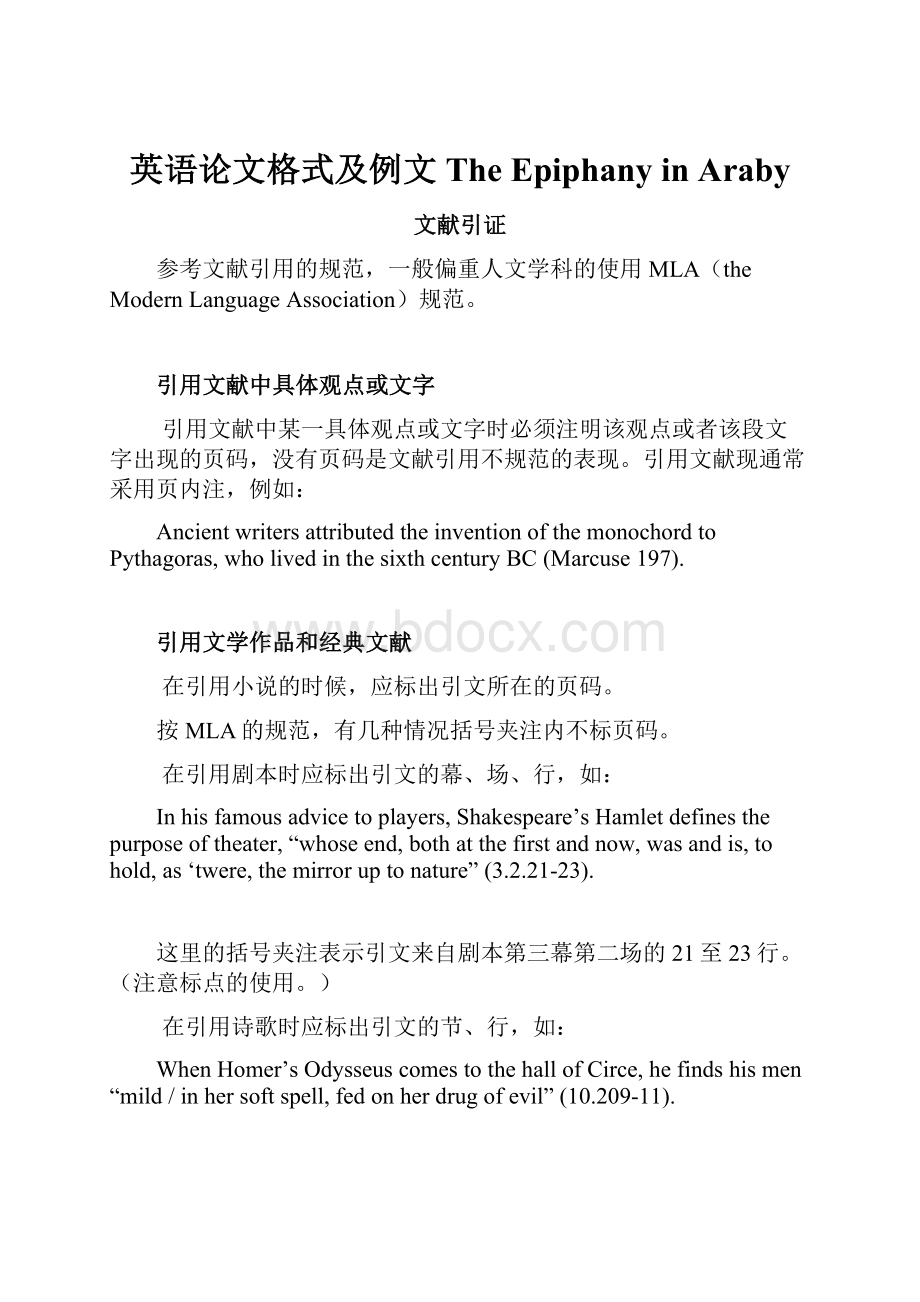英语论文格式及例文 The Epiphany in Araby.docx
《英语论文格式及例文 The Epiphany in Araby.docx》由会员分享,可在线阅读,更多相关《英语论文格式及例文 The Epiphany in Araby.docx(10页珍藏版)》请在冰豆网上搜索。

英语论文格式及例文TheEpiphanyinAraby
文献引证
参考文献引用的规范,一般偏重人文学科的使用MLA(theModernLanguageAssociation)规范。
引用文献中具体观点或文字
引用文献中某一具体观点或文字时必须注明该观点或者该段文字出现的页码,没有页码是文献引用不规范的表现。
引用文献现通常采用页内注,例如:
AncientwritersattributedtheinventionofthemonochordtoPythagoras,wholivedinthesixthcenturyBC(Marcuse197).
引用文学作品和经典文献
在引用小说的时候,应标出引文所在的页码。
按MLA的规范,有几种情况括号夹注内不标页码。
在引用剧本时应标出引文的幕、场、行,如:
Inhisfamousadvicetoplayers,Shakespeare’sHamletdefinesthepurposeoftheater,“whoseend,bothatthefirstandnow,wasandis,tohold,as‘twere,themirroruptonature”(3.2.21-23).
这里的括号夹注表示引文来自剧本第三幕第二场的21至23行。
(注意标点的使用。
)
在引用诗歌时应标出引文的节、行,如:
WhenHomer’sOdysseuscomestothehallofCirce,hefindshismen“mild/inhersoftspell,fedonherdrugofevil”(10.209-11).
这里的括号夹注表示引文来自诗歌第10节的209至211行。
对不分节的诗第一次引用时应说明括号里标的是行数,使用“line”,以后的引用则不需再说明。
例如:
第一次引用:
(lines5-8)
以后的引用:
(12-13)
在引用有章节、分册的小说的时候,应标出引文所在的页码、册数、章节,如:
OneofKingsolver’snarrators,teenagerRachel,pusheshervocabularybeyonditslimits.Forexample,RachelcomplainsthatbeingforcedtoliveintheCongowithhermissionaryfamilyis“asheertapestryofjustice”becauseherchancesoffindingaboyfriendare“dullandvoid”(117;bk.2,ch.10).
例子里的括号夹注表示引文来自该书第二册第十章的第117页。
(注意标点和缩略语的使用。
)
参考文献著录的格式
参考文献著录在MLA规范里叫做WorksCited。
著录已出版的文章
一位作者写的文章
Stewart,DonaldC.“WhatIsanEnglishMajor,andWhatShouldItBe?
”CollegeCompositionandCommunication40(1989):
188-202.
两位或两位以上的作者写的文章
Mascia-Lees,FrancesE.,PatSharpe,andColleenB.Cohen.“DoubleLiminalityandtheBlackWomanWriter.”AmericanBehavioralScientist31(1987):
101-14.
收集在书籍中的文章(Selectionfromaneditedbook)
Glover,David.“TheStuffThatDreamsAreMadeOf:
Masculinity,Femininity,andtheThriller.”Gender,GenreandNarrativePleasure.Ed.DerekLonghurst.London:
UnwinHyman,1989.67-83.
著录已出版的书籍
一位作者写的书籍
Graff,Gerald.ProfessingLiterature:
AnInstitutionalHistory.Chicago:
UofChicagoP,1987.
两位或两位以上的作者写的书籍
Jakobson,Roman,andLindaR.Waugh.TheSoundShapeofLanguage.Bloomington:
IndianaUP,1979.
再版书(Bookwithanewedition)
Erikson,Erik.ChildhoodandSociety.2nded.NewYork:
Norton,1963.
编撰的书籍(Editedbook)
Kerckhove,Derrickde,andCharlesJ.Lumsden,eds.TheAlphabetandtheBrain:
TheLateralizationofWriting.BerlinSpringer-Verlag,1988.
翻译的书籍(Translatedbook)
Lacan,Jacques.Ecrits:
ASelection.Trans.AlanSheridan.NewYork:
Norton,1977.
著录汉语著作和文章
如果在英文撰写的论文中引用中文著作或者期刊,括号夹注中只需用汉语拼音标明作者的姓氏,相应的,参考文献著录的条目必须按作者姓氏汉语拼音的字母顺序与英文文献的条目一同排列。
条目中凡正文中未加引用的内容均不必翻译。
例如:
Wang,Shouren[王守仁],现代化进程中的外国文学与中国社会现代价值观的构建.外国文学评论,2004,(4):
99-104
Zhang,Zhijian.[张志健],严复思想研究.桂林:
广西师大出版社,1989
引用中文期刊文章,必须标明文章出现的页码。
条目中的汉语不得使用斜体。
著录网络出版物
著录网络出版物必须标明出版物的上传日期和论文撰写人上网查询的日期(dateofretrieval),标明网址。
条目中网址如需断开换行,必须在“/”之后或者“.”之前,网址中不得出现空格。
网络期刊(onlinejournal)上的文章
(1)纸印期刊的电子版:
Bleich,Eric.“FromInternationalIdeastoDomesticPolicies:
EducationalMulticulturalisminEnglandandFrance.”ComparativePolitics31.1(Oct.1998):
6pp.ExpandedAcademicASAP.MiddleburyCollege2Aug.2003//myriad.middlebury.edu/verify-iac>.
该例中,“6pp.”表示文章有6页,“ExpandedAcademicASAP.MiddleburyCollege”为网页名称,“2Aug.2003”为论文撰写人上网查询的日期。
报纸电子版中的文章
Verhovek,SamHowe.“MicrosoftsMightBeBetterThanOne.”TheNewYorkTimes.1May2000.3June2001<00/05/Biztech_articles/01seat.html>.
来自网络讨论区(onlinenewsgroup,forum,ordiscussiongroup)的信息
著录来自网络讨论区的信息,如果作者提供了真实姓名,则条目必须使用其真实姓名,否则使用作者在讨论区使用的姓名。
条目必须提供信息上传的具体日期、讨论主题(subjectline)等。
Stevens,Melissa.“TakeOurDaughterstoWorkDay.”Onlineposting.24Apr.2001.CareerandWorkplaceIssuesForum.2May2001<
网络上的参考资料(Onlinereferencesource)
“Fresco.”BritannicaOnline.Vers.98.2.April1998.EncyclopediaBritannica.8May2000<:
180>.
注意:
本例中“Vers.98.2”为版本,“April1998”为出版日期,“EncyclopediaBritannica”为出版人。
参考文献的排列
参考文献的排列在MLA的规范里须遵循以下规则:
(1)文献条目按作者或第一作者姓氏的字母顺序排列,如:
Cressy,David.Birth,Marriage,andDeath:
Ritual,Religion,andtheLifeCycleinTudorandStuartEngland.NewYork:
OxfordUP,1997.
Nobles,GregoryH.AmericanFrontiers:
CulturalEncountersandContinentalConquest.NewYork:
Hill,1997.
Said,EdwardW.Orientalism.London:
Routledge&KeganPaul,1978.
(2)同一作者的多篇文献,由远及近排列,第二篇开始用三个连字符“-”替代姓名,如:
Frye,Northrop.AnatomyofCriticism:
FourEssays.Princeton:
PrincetonUP,1957.
---,ed.DesignforLearning:
ReportsSubmittedtotheJointCommitteeoftheTorontoBoardofEducationandtheUniversityofToronto.Toronto:
UofTorontoP,1962.
---,TheDoubleVision:
LanguageandMeaninginReligion.Toronto:
UofTorontoP,1991.
Final-termPaper
Topic:
WriteacriticalanalysisofRobinsonCrusoe
Due:
December31,2009
Length:
About800words(atleasttwopages).
∙Don’tretellthestory.Pleaseformulateanargumentofyourownandfindsignificantdetailstosupportit.
∙MakeeffortstowritecorrectandidiomaticEnglish.
请同学们注意英文体例:
1) Forthetitleofashortstoryorapoem,quotationmarksareused;andthetitleofanovelorplayisitalicizedorunderscored,e.g.,"Araby","OdetotheWestWind",GreatExpectations,Macbeth.
2) Usesimplepresenttensetonarratetheplotofthestory.
3) Adoptthirdpersonpointofviewandavoidoveruseofpersonalexpressionssuchas"Ithink","Ibelieve",and"Ilikethestory".
4) Commentsbycriticshelpyoutoenhanceyourargument,butyoumustgivetheirsourcestoavoidplagiarism,thatis,youmustindicateclearlythatyouarequotingotherpeople'sideas.
5) Inwritingyouressay,alwayscheckifgrammariscorrect,wordsarewellchosen,andexpressionsareidiomatic.
注意:
如发现抄袭,论文以零分算。
Inwritinganessayitisimportanttoasktwoquestions.Thefirstquestionistheordinaryone:
Whatismyargument?
HavingdecidedwhatIplantoargueandassert,thesecondquestionwouldbe:
HowcanIpresentmyargumentinacompellingway?
Awelldesignedtopicavoidstwothings.First,asituationinwhicheverythingseemstoberelevantandequallyuseful.Inthatcasetheso-calledtopicisjustawayofparaphrasingtheentirebook:
"JaneEyre'sLife"or"ExperienceinJaneEyre"wouldbeexamplesofthinlydisguisedparaphrasetopicsforthebookasawhole.Thesecondthingtoavoidisthedesignofanytopicisasubjectthatseemstoinviteyoutowriteapaperthatstructuresitselfbymeansofthenovelitself,beginningwiththebeginningandfindingitself,initsfinalpages,comingroundtoadiscussionoftheend.Thenovelisnarrative.Apaperisananalyticpieceofwriting.
Tobeagoodtopicitmustbecarefullylimited.Itmusthaveanelementoffreshness,evenofunexpectednessaboutit.Everytopicleadsyoutospecificlocationsinthetextofcrucialmoments(paragraphs,turns,objects,andimages)whichshedlightonthecentralthemeofthetext.
Notallevidenceisequal.Eachdetailintroducedshouldnothavethesamelengthofanalysis.Someevidenceismentioned,someoccursinalist,someisusedtoprepareforacarefullyanalyzedcentralinstance,andsomecarefullychosendetailisusedtosituatethetopicintheopening,andlastbutnotleast,someequallycarefullychosendetailiswithheldsoastopermitafinalturn,asurprise,asuddenexpansionofimportanceintheclosingstageofthepage.
Asampleessay:
TheEpiphanyin“Araby”
“Araby”isastoryaboutayoungromantic’sfirstbittertasteofreality.Hedespisesthesecularismandtriestobreakawayfromitsrestriction;however,inthefaceofthereality,allhishopesanddreamsareprovedtoofragile.JamesJoycedoesnotarrangetheplotsofthestoryaccordingtothetraditionalwaywhichusuallydevelopsfromconflictstoclimax;instead,headoptsthemethodofepiphanytosignifythetheme.Epiphanyin“Araby”enhancestheprofoundandphilosophicalmeaningofthestory.
ByanepiphanyJamesJoycemeans“asuddenspiritualmanifestation,whetherinthevulgarityofspeechorofgestureorinamemorablephaseoftheminditself”(Attridge191).In“Araby”,theepiphanyisstimulatedbythevulgarityofspeechandgestureinthebazaarthatistheplace“mosthostiletoromance”(Joyce160).Arabyhasmeantalottotheboyand“castanEasternenchantment”(Joyce161)overhim.ItistheplacewherehecanbuyagiftforMangan’ssisterandtheplacewherehisdreamsmaystarttocometrue.Butwhatheseesthereis“twomencountingmoneyonasalver”andwhathehearsis“thefallofthecoins”(Joyce162).Theplaceheeagerlylookedforwardtoistheonefullofthestinkofmoney.Whatdiscourageshimevenmoreisthebeautifulyoungladyinthebazaar.Sheflirtswiththetwoyounggentlemenandisreluctanttotalkwiththeboywhoseemstoopoortobuyanything.Theboyissensitiveenoughtofeelthelady’sdisdain.ThismustremindhimofMangan’ssisterwhoisalsoverybeautiful,butastowhatisbehindtheappearance,heknowsnothing.HeoncelongedsoeagerlytogototheArabytobuyagiftforMangan’ssister,butinsuchsituation,heisperplexedandfrustratedbytherealityandevenremembers“withdifficulty”(Joyce162)whyhehascome.Stimulatedbythevulgarityofspeechandgestureinthebazaar,hesuddenlyrealizesthatallhisromanticillusionsareridiculousanddoomedtobethwartedbytherealisticcircumstances.StandingaloneindarkenedArabywithhisshatteredhopes,hiseyes“burnedwithanguishandanger”(Joyce163).
Theepiphanydoesneedsomestimulationandthevulgarityofspeechandgestureinthebazaarisagoodstimulus,butbesides,theepiphanyalsoneedsdeepgoingaccumulations.“Hehasnotbeendefeatedbyashabbybazaar,orevenbyrealityinthe